Wednesday, August 30, 2006
A Small Tour of a New Orleans Neighborhood, Part the First
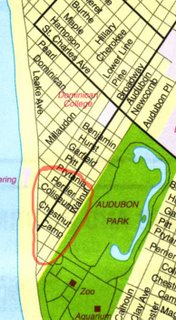
I'm going to show you a bit of a relatively unaffected neighborhood of NOLA. I've circled the area where I took these pictures in red. That's the river to the left edge of the map in blue. St. Charles Ave. intersects S. Carrollton at a right angle near the top left. Broadway is the large street running through the center of the red circled area.
This is a New Orleans neighborhood that suffered probably the least amount of damage of anywhere in NOLA. No flooding at all, just wind damage for the most part, although hurricane wind damage isn't to be dismissed. The steady blowing of winds, usually well over 80 mph, takes a toll quickly on even well-constructed roofs. Of course, if a house gets roof damage, it inevitably follows that some water damage will occur from rain and leaks.
Yet, as you will see, there was plenty of damage still to be seen here in mid-August, 2006, close to a year after the disaster.
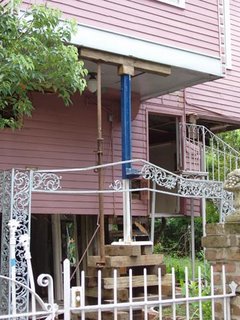 This lavender house is in the process of being jacked up, I think. Over to the right of the doorway you can see what appears to be a stair railing which used to go to the part now being supported by the blue jack. They must have been in a hurry to jack it up because it looks like the jack ripped through the wrought iron fencing as it went up.
This lavender house is in the process of being jacked up, I think. Over to the right of the doorway you can see what appears to be a stair railing which used to go to the part now being supported by the blue jack. They must have been in a hurry to jack it up because it looks like the jack ripped through the wrought iron fencing as it went up.These next two pictures are different angles of the remains of a convenience store/deli that used to be at the corner of Audubon St. and Magazine St. I don't really know what happened to it but the ruins show some signs of fire. There is no indication it will be rebuilt anytime in the near future. This emptiness is difficult to convey, the sense of many loose threads in the fabric of the city. There is no closure here; the rubble is a mute epitaph to someone's business and livelihood. Where are they now? Who knows?
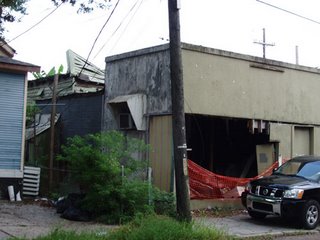
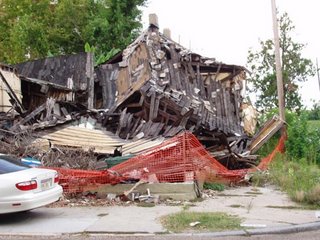
Below are a few shots of these portable mini-storage stations which pop up in yards and even on the streets, wherever there's room near a house. I assume that people use them for storing valuables/things they are sorting through in their house. If you aren't actually living in the house fulltime, you probably don't want to leave your possessions out, even in a locked house. This provides a kind of security for some items. I originally thought they were used to keep workers' tools during renovation, providing a means of securing tools that are in high demand in NOLA. But your guess is as good as mine. These mini-sheds are probably used both ways and others I can't conceive.
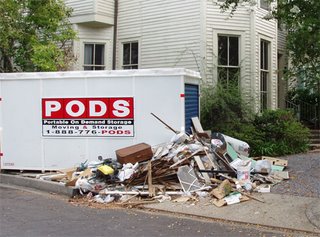
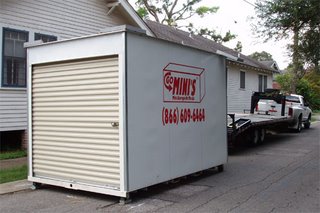
I think I'll break here and continue later.
A Culture of One
Collective membership is both harder and easier than ever before but the real world results are less than ideal. When you can walk away or leave a group if things get difficult on an interpersonal level or when achieving goals requires more sacrifice than is convenient, you have a different expectation of such groups. You become a little less committed, a little less determined to see the project through thick and thin.
This is what I call the culture of one. I don't mean it in a good way.
In this vacuum of deep connection, we are left to try to feed the empty space with the frizzy cotton candy of popular culture. Even the nuclear family, considered by the political and religious right the sine qua non of larger culture, is transformed into strangers passing on their way to different events, probably spending the majority of their time together asleep under the same roof.
A blog is a good example of this culture of one. While I like meeting new people and interacting on the web, it is a very disconnected and alienating form for interacting with other people. While I do meet new people who I want to know better, it is still a removed and distanced experience, lacking in essential in-person qualities. It is an intellectual experience, different from the sensorium of direct physical interaction.
A culture of one is inherently nihilistic and selfish, caring less for other people than oneself. I will venture out on a limb and say this is bad thing. What do you think?
Monday, August 28, 2006
Another Blind Empire Falling
Of course, the reason it takes so long for him to move through a subject is because he entwines other threads along with his main points. It is often skillful and beautiful writing and, as a writer, I admire it on that level. On another level, I keep wanting him to be more concise, hone the text a little more. That's my editor voice talking. I suspect (and this is not a final judgment since I've only read a small percentage of the whole) these two volumes could have been distilled into one but it's difficult to say for sure and I don't see a lot of obvious flab to the text.
A more satisfying read (for me at least) is Dark Ages America: The Final Phase of Empire by Morris Berman. After catching the last half of a segment on BookTV/C-SPAN, I thought it would be worth reading and it is. He does not offer solutions but describes why he thinks America is on the declining side of empire. I could quibble with the relative importance of some of the symptoms he notes but not with the general overall picture he paints. Seek it out. Don't expect happy talk though. I think it's better to face grim truths than pretend they don't exist. Paradoxically, I feel much better when someone articulates truths I observe but never hear anyone talking about, particularly not in the media. When no one talks about events and trends that seem obvious to me, it can make me feel a little crazy, a little outside of consensus reality. This is a danger of our mass media: so focused on the immediate and finite events that a broader analysis is never even attempted.
Sunday, August 27, 2006
The Post-K Era
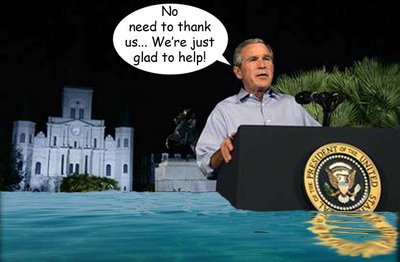 There is a pair of phrases in New Orleans: Pre-K and Post-K. These seem patterned after that oft-used political bludgeon phrase, "That's pre-9/11 thinking in a post-9/11 world." In NOLA, history is currently divided by the events of Hurricanes Katrina/Rita. What is "normal" now was inconceivable to most New Orleanians Pre-K. Despite NOLA's long history of hurricanes and flooding, the reality of such a massive level of flooding was beyond most inhabitant's concept of "worst case scenario" except in purely theoretical terms.
There is a pair of phrases in New Orleans: Pre-K and Post-K. These seem patterned after that oft-used political bludgeon phrase, "That's pre-9/11 thinking in a post-9/11 world." In NOLA, history is currently divided by the events of Hurricanes Katrina/Rita. What is "normal" now was inconceivable to most New Orleanians Pre-K. Despite NOLA's long history of hurricanes and flooding, the reality of such a massive level of flooding was beyond most inhabitant's concept of "worst case scenario" except in purely theoretical terms.Understand: New Orleanians have lived with the possibility of such destruction all their lives. Even as a child of 10 or so, I knew the pumping stations were the only things that kept the city relatively dry and livable. I even knew when my mother moved to her current home that one of the considerations of the location was that it was high ground. Well, high ground for NOLA. The difference between the highest and lowest ground elevations is probably not much more than 15 feet, not counting the levees.
Speaking of flooding, while I was in NOLA they performed a test of a new pumping system on the 17th St. Canal. You know, one of the canals that broke. New floodgates have been installed at the mouth of the canal on Lake Pontchartrain to prevent a tidal surge from entering and breeching the levees again. When they switched on the new water pump, it vibrated so much the test had to end. This was in mid-August. The project was supposed to be completed in June before hurricane season began. C'est la vie. Or C'est la mort as the case may be.
A little problem with putting floodgates on the canal is that the canal is the outflow for another major pumping station which keeps the uptown area dry when it rains. The new pumping station is designed to pump water up/around the new floodgates. However I've been told the new pump only pumps out one tenth the amount of water the main pump puts into the canal. You do the math: close off canal, pump out 1/10 of what is being pumped into it. A sixth grader in my sister's class (sis is a teacher) said "That's dumb." Yes, a 6th grader could see the flaw in the plan but apparently the engineers thought the solution was good enough. It's not like we have any reason to question their competence.
And finally, I recommend NOLA.com, the online version of the New Orleans Times-Picayune. You'll probably find much more of the reality of what is going on in New Orleans in the T-P than the "special" coverage for the anniversary of Katrina. They also have a nice Flash map of the city and rebuilding progress.
Saturday, August 26, 2006
Breakfast Amongst the Ruins
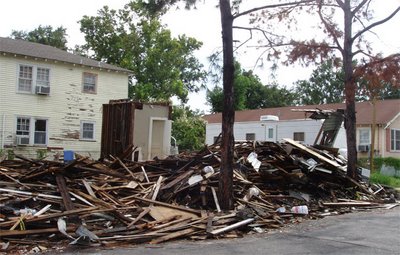
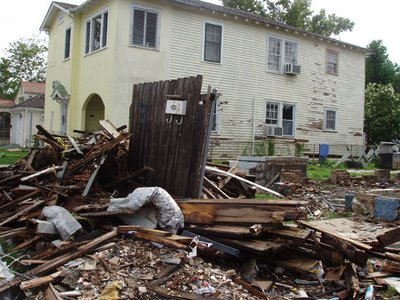 Another couple of photos from my first day in NOLA. These are from the same site. My sister D-- was surprised because this house had come down since the last time she was through this area of the Broadmoor section of the city.
Another couple of photos from my first day in NOLA. These are from the same site. My sister D-- was surprised because this house had come down since the last time she was through this area of the Broadmoor section of the city.Now I will admit to my cowardly nature: I was unable to bring myself to visit the worst desolation of NOLA, the lower 9th Ward and East New Orleans. I only barely made it to the downtown area on my last day (to have a fried oyster po-boy at "The Pearl" on St. Charles Ave. near Canal St.). I didn't really bother to look at the French Quarter. I tend to think of the Quarter as the reservation for tourists and, although there is much to see that is quintessentially NOLA there, it's not very representive of the NOLA I carry in my memory. Technically, the French Quarter is an area only about six by fifteen city blocks in size.
Oh, I saw plenty of desolation and ruin but you would do well to remember I visited mostly the uptown area between St Charles Ave. and the river. This area did not flood at all. Most damage was from wind and falling trees. I also have pictures from the Broadmoor neighborhood which was flooded, some of it seven to nine feet deep, I think. But many of the people living in the Broadmoor area apparently had access to the resources to repair their property damage. Not everyone, but I would estimate the majority did. And where I was staying (on a small residential street near Audubon Park) arguably had the lightest damage of anywhere in NOLA. Only one or two houses in every block still showed much visible damage almost a year after the hurricanes.
Elsewhere was another story.
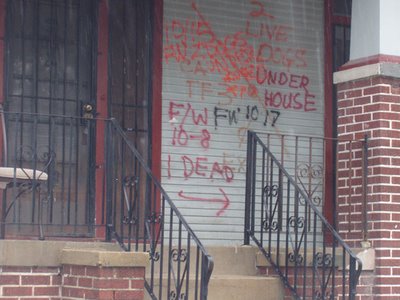 Despite not getting to the lower 9th, I did see less fortunate areas such as the section of Tulane Ave. from downtown to S. Carrollton Ave. And they were a horror show of wreckage. Homes and businesses, obviously completely abandoned since the flooding, were always in sight. Sometimes long stretches contained no buildings with signs of renovation.
Despite not getting to the lower 9th, I did see less fortunate areas such as the section of Tulane Ave. from downtown to S. Carrollton Ave. And they were a horror show of wreckage. Homes and businesses, obviously completely abandoned since the flooding, were always in sight. Sometimes long stretches contained no buildings with signs of renovation.The picture with the "2 LIVE DOGS UNDER HOUSE" sign is from a house I picked pretty much at random along Tulane Ave. In other words, I didn't have to search hard for such a message. Unless it has been painted over, most houses still have these remaining notices from the house-to-house searches in the weeks following the hurricane. Note some of the dates: 10/8 and 10/17. That's the middle of October, five to seven weeks after Katrina. I don't think the "1 DEAD" refers a dog since it seems to pre-date the dog messages.
I'm uncertain whether anyone is reading these posts so drop me a comment on what you think of my observations. Are they depressing you? Do you have any questions? Let me know and I'll try to answer in a subsequent post. I'm feeling a bit compulsive about documenting this stuff before it slips my mind. So you can expect several more posts in this same vein.
Happy happy, joy joy.
Friday, August 25, 2006
Permanent Bathtub Ring Around NOLA
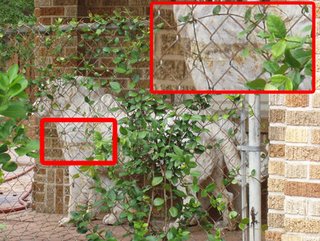 I'm torn in several directions. Offline I'm working on a writing project detailing my visit to New Orleans. This may be bigger than I have the stomach to finish. I want to put some of these observations in this blog but my mind reels erratically from one image to another, one story to another, one loss to another. I'm feeling jagged and less focused than I want to be about this process.
I'm torn in several directions. Offline I'm working on a writing project detailing my visit to New Orleans. This may be bigger than I have the stomach to finish. I want to put some of these observations in this blog but my mind reels erratically from one image to another, one story to another, one loss to another. I'm feeling jagged and less focused than I want to be about this process.The result is that I'm impulsively posting my stories in no particular order. I'm not writing these offline; I'm just jamming on what catches my fleeting attention and running it out here. So excuse me if this has the air of loose and jangled nerves.
The picture above is one of the first I took in New Orleans. My sister showed me this lion sculpture that had been removed from the front of the house and put in the back yard. The enlargement is of a waterline on the chest of the lion. This was the first waterline I had seen in NOLA, the highwater marks left by the floods. I was strangely excited by this remnant, like I had found the secret signs of the now-hidden disaster. I had no idea yet what sights awaited.
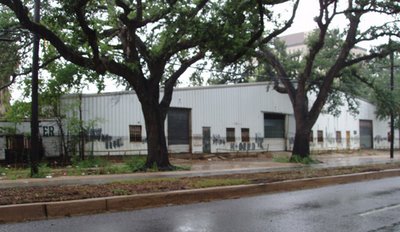 This picture was taken on Tulane Ave. the day before I left NOLA. Yes, that line on the building is another waterline. For some reason these reminders struck me harder than all the photos of floodwaters in the weeks after the hurricanes. Perhaps it was because the water also hid what was below it. The STOP signs poking above the water and half submerged buildings were eerie and horrible but this line of demarcation was everywhere around the city. In some neighborhoods you had to look carefully. Repairs, scrubbing and paint had almost erased it but if you were observant, it wasn't difficult to see it on fences or on door jambs.
This picture was taken on Tulane Ave. the day before I left NOLA. Yes, that line on the building is another waterline. For some reason these reminders struck me harder than all the photos of floodwaters in the weeks after the hurricanes. Perhaps it was because the water also hid what was below it. The STOP signs poking above the water and half submerged buildings were eerie and horrible but this line of demarcation was everywhere around the city. In some neighborhoods you had to look carefully. Repairs, scrubbing and paint had almost erased it but if you were observant, it wasn't difficult to see it on fences or on door jambs.Here's a quote is from Chris Rose's 1 dead in attic: "Consider the sights, sounds and smells you encounter on a daily basis as you drive around a town that has a permanent bathtub ring around it. I mean, could somebody please erase that brown line?" I'm not sure whether people not native to NOLA get as much out of this book as I did. I know almost every location he mentions. I shopped at the stores he names. Most of it isn't the NOLA tourists know; it's the NOLA of people living there, of the daily round of everyday life.
As we come up on the anniversary of Katrina and Rita next Tuesday, I'm beginning to hear the insipid recaps of the events on the news. I doubt we'll hear much about a plan that could rebuild the delta marshes and provide a buffer against future hurricanes. This is called Coast 2050: Toward a Sustainable Coastal Louisiana. Pre-Katrina, its price tag of $14 billion seemed very large. It seems like a bargain now, the equivalent of about five weeks of the cost of the Iraq war and the "War on Terror". Certainly much less than the $110 billion spent on recovery of the area.
But we won't hear about that probably. We'll be given misdirection and blame and the amount of money spent and the number of FEMA trailers and statistics and footage of plucky Republican Rocky Vaccarella of New Orleans meeting with Prez. Bush. We'll hear about band-aids and reaction rather than proactive solutions to the loss of 1 million acres of wetlands in Louisiana over the last 100 years.
I think I'll go watch TV.
Thursday, August 24, 2006
Intimations of New Orleans Today
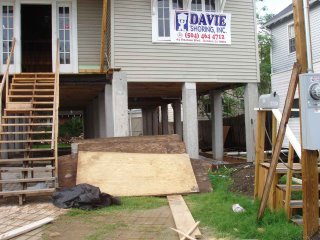 I've just gotten back from a six day trip to New Orleans, my first since hurricanes Katrina and Rita smashed through there almost a year ago. I'm not quite sure what I'm going to write up about it but as a teaser I'm including a photo as a sample of what is to come.
I've just gotten back from a six day trip to New Orleans, my first since hurricanes Katrina and Rita smashed through there almost a year ago. I'm not quite sure what I'm going to write up about it but as a teaser I'm including a photo as a sample of what is to come.The house you see here is in the Broadmoor area of NOLA, roughly centered around Fountainbleau Dr. and Nashville. Note the concrete stilts supporting the house. Those are new. The house has been raised 9 1/2 feet from its original (and flooded) level. It is my understanding that this modification is in accord with the FEMA guidelines for rebuilding and renovating in NOLA. The cost to raise a house like this one? Nearly $50K on top of other repairs. To the far right, behind the electrical box, you can see a mailbox on the stair railing leading up to one of the ubiquitous FEMA trailers. You often find these trailers next to houses being renovated.
However a problem with rebuilding in NOLA is that there are few official guidelines yet. Or, rather, there are several different standards that are not consistent with each other. The city government of NOLA has one standard, FEMA has another, the state government of Louisiana has yet another, and various foundations/organizations donating money have their own. So the homeowner's problem is: Do you rebuild now or wait indefinitely for an "official" decree? And no one knows when these details will be ironed out. There are some programs for distributing aid money to help homeowners rebuild that haven't even started interviewing people to qualify for the grants. Those programs may not actually begin distributing any money until March of 2007. The kicker: to qualify for some of these funds you have to rebuild to their standards. So if you go ahead and repair things now but not to the right standard (still to be decided), you're out of luck. And people with unliveable houses are unlikely to wait for such an indefinite future. They need a place to live ASAP. Living in a trailer or another city gets old fast.
These are just some of the things I learned in NOLA. I'm going to write up a day-by-day diary of the trip with side explorations of some issues I think are important.
Monday, August 14, 2006
Another Wide-Eyed Punter in Thrall
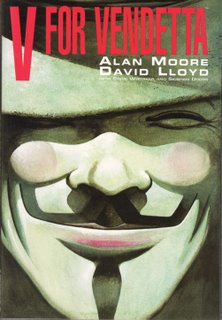 Like so much of my mental process, the title of this post is inscrutable and narcissistic to the outsider; obscure and cryptic phrases are a specialty of mine.
Like so much of my mental process, the title of this post is inscrutable and narcissistic to the outsider; obscure and cryptic phrases are a specialty of mine.I finally saw V for Vendetta on DVD a little while ago and enjoyed it. There were some alterations from the graphic novel/comic in this adaption for the screen but, by and large, these were concessions to the limitations of film storytelling rather than neutering of the strong anti-authoritarian themes. The film is remarkably well-attuned to the zeitgeist of the post 9/11 USA. I was sorry to note the dilution/excising of the Anarchist content. (This was apparently a big issue for Alan Moore, the writer of the original comic, and he completely disassociated himself from the film version.) Still, the film is very well done and I enjoyed it. The parallels to the current US administration and policies are obviously intended and unmistakable. It's also a measure of my ignorance of English culture that I read the entire comic without ever recognizing that the iconic mask "V" wears is a likeness of Guy Fawkes. D'oh! I also recommend reading the graphic novel if you are interested in a more complex and nuanced version of the story. With the popularity of the film, the graphic novel has seen much broader distribution recently so should be easier to find at mainstream bookstores. At 300 pages, it's a chunky read and worth the price ($20).
My recent reading has been quite fun. Armed Madhouse by Greg Palast is great and should be required reading. I sometimes find his humor a little, um, stupid and forced but the detail and signal/noise ratio is worth it. It's a bleak picture he paints but I'd rather know the bad stuff than try to live in blissful ignorance. His reporting on the manipulations by the GOP of the elections in 2000 and 2004 is particularly interesting and compelling. This is the information I thought I would get in Fooled Again by Mark Crispin Miller. Palast makes me really hate the Democrats. They are either stupid or frozen with indecision over the issue of election and voter massaging by the GOP. I was also impressed with his research on the whole "peak oil" theory and his analysis of the motivations behind the whole Iraq invasion. Totally worth reading.
A book that I want to read is Dark Ages America: The Final Phase of Empire by Morris Berman. (His blog on the book is here.) I saw the end of a segment with the author on BookTV on C-SPAN and liked what I saw. Apparently some people find his writing pessimistic and lacking in "uplifting" conclusions but I suspect there is a Cassandra effect at work. That, and he seems totally unapologetic about his views about the decline of the American Empire. I'm undoubtedly stating the obvious with the observation that inhabitants of an empire in decline rarely note the circumstances of the decline until said decline is in an advanced stage.
More on my recent reading later. Ciao!
Saturday, August 12, 2006
While the Bombs Fall by Starhawk
Here's a recent post I recieved from Starhawk. I think her argument about the cycle of violence and retaliation is a valid one.
While the Bombs Fall
By Starhawk
While the bombs fall in Lebanon, I’m teaching a two-week course in permaculture: regenerative, ecological design, with a schedule so demanding that I find it hard to check email every day, let alone watch the news. But it comes in, between lesser messages about leaks in the watering system in the garden and flight cancellations: pictures of dead children on the road. I feel horrified, angry, frustrated, powerless…all the things I’m used to feeling about the situation, but more so. I try to write something in the spare moments when my teaching partner Penny is covering rain catchment or graywater systems, but all I keep writing, over and over, is “Killing children is wrong.” That sees so self-evident and banal that I can’t quite bring myself to send it out. Or rather, it doesn’t seem to add much to a discussion in which the decision makers are so convinced that killing our children is very, very wrong, but killing their children is the Path of Righteousness.
While the Congress and Senate are voting their support for Israel’s actions, I am teaching systems theory and strategy, including an essay by Donella Meadows, “Nine Ways to Intervene in a System (in increasing order of effectiveness.) The least effective way, she says, is by changing amounts. Please, General, can we drop fewer bombs? Can we keep it proportional? Could we scale down to killing just maybe two of their children for every one of ours, instead of ten?
The situation itself is a perfect example of what she calls a positive feedback loop. I find the term confuses people, as there is often nothing positive about it. I call it a self-reinforcing cycle. Whichever, it means a situation in which the more you have of something the more you get, and the more you need. You kill some of my children so I kill more of yours, so you kill more of mine, so I kill even more of yours.
Self-reinforcing cycles are engines of change, for better or worse. They get more and more extreme, until either some new constraint enters to impose a new equilibrium, or they crash. Hurricanes suck up energy from the heat in the sea, and grow bigger, sucking more energy, which makes them bigger still, until they hit land and blow themselves out. Addicts keep taking more of what they’re addicted to, until they hit bottom, whether the addiction is to alcohol or heroin or military intervention.
This quality of systems does not bode well—either for the children of Beirut or those of Haifa. Europe and the UN might make some weak attempts to intervene, but as long as the U.S. is cheering the Israeli government on, no serious constraints will be imposed. And why shouldn’t we cheer them on, when Israel’s addiction to force as a solution is the mirror of ours? We’re the big guy and the small guy, standing each other drinks at the pub and throwing the chairs at anyone who threatens us, until we smash the place.
It is this very self-reinforcing cycle that keeps power in the hands of the neo-cons, whose answer to every fear and insecurity is more force. Force which creates more fear, which generates more violence, which requires more force to keep down. It’s an inherent aspect of being caught in this sort of system that as it begins to spiral out of control, and starts to break apart, the only solution you can see is more of the same. An alcoholic gets fired for drinking on the job, and drinks more to forget. Iraq is not working out well for Bush and the neocons, so bring in more troops, or expand the war—Lebanon, Syria, Iran.
You can’t change a self-reinforcing system by changing amounts. Recovering alcoholics know this, generals and politicians don’t. Try to limit yourself to one drink before dinner, and somehow you still end up behind the wheel of the car that careens into the bus full of schoolchildren on the road. Tell yourself that you are using a measured, limited response for well-thought out political aims, and you still end up with blackened torsos and the severed limbs of infants in smoking piles on the motorway.
Here’s some other things we know about these cycles—they are expensive. They consume resources. Drinking up the children’s milk money down at the local. Starving every social program to fund our military. And when they crash, they often fall hardest on the undeserving. The drunk behind the wheel rolls out of the crushed car, unharmed, while the family of five lies dead. The policy makers are not cringing in tenements as bombs fall, or crying over the bleeding body of their most beloved child. Nor are most of those who support the policies. Yet.
To change the system, you need to change the paradigm, the way you frame the situation and think about it, the deep assumptions that shape your viewpoint. That’s Donella Meadows’ most effective way to intervene—changing the world view and the constructs that support the system. It’s also, generally, a hard and painful process.
A new paradigm, a new construct of self and world, goes against everything we know and believe. If I’m telling myself that I’m a fun-loving, party kind of a gal—how painful to instead admit that I’m an alcoholic! If I’m justifying the deaths of children by telling myself that I’m bringing democracy to the region, or safeguarding my sister’s children in Hadera, or fulfilling God’s plan, how painful to look at the broken bodies on the pavement and say, “I did that. I have blood on my hands.”
I’m thinking about one of the many fruitless arguments I’ve had about the issue, this one with an ultra-Orthodox rabbi’s wife, shortly after I’d returned from doing solidarity work with the nonviolent Palestinian resistance in Gaza and the West Bank. I tried to describe to her what I’d seen in that bullet-riddled, shell-shocked land, the ongoing, everyday horrors and humiliations and frustrations, the houses bulldozed, the farmlands confiscated, the lives blunted and stunted and blasted into oblivion, and at the end she said to me:
“But we’re good. So if we’re doing it, it must be good.”
That’s one hard paradigm to shift, because there is nowhere to go from that pinnacle but down, no change we can make that doesn’t require us to face the possibility that maybe we are bad, or at the very least, that we are good people doing some bad things. From that vantage point, of course any critique, no matter how measured, seems anti-Semitic, an assault on that basic self-definition of Essential Goodness.
While the killing escalates, I am teaching about soil. How to feed the life of the soil, how to encourage and nurture the worms and the beneficial bacteria and fungi and other soil organisms. How a healthy soil will grow healthy plants, that can resist pests.
Industrial agriculture, in contrast, is based in the same exact paradigm as our Iraq policy, one that was succinctly expressed in a bumper sticker my first husband applied to his van shortly before we broke up: “Force, It Works!”
So, if corn borers are attacking your crop, blast it with insecticides. Kill the bastards! Are there weeds among the fields? Zap them with roundup. Root feeding nematodes, perchance, below ground? Blanket the whole thing in plastic, and gas it with methyl bromide.
Force—it works, for a while, perhaps for short term goals. But force is costly. And, whether we’re employing force against bugs or bacteria or human beings, force breeds resistance.
And so insects that survive the onslaught of the pesticides breed young that are not affected. We up the doses, and breed more and more resistant pests, which require more insecticides to kill, in another self-reinforcing cycle. The helpful insects, the predators that might have kept the pests in balance, are wiped out. And the residues of poison remain, in the soil and in the crops themselves.
Human beings are not insects or bacteria. The human resistance that force breeds is not in the genes, but in hearts and minds. And so the bombing of Beirut breeds rockets falling on Haifa and airplane bombers in London, and all the assaults on South Lebanon, the bombs and blown-up bridges and armed teenage boys in uniform on the ground will breed more rockets yet, more suicide bombs of the future, more death in retaliation.
And the devotion to force is itself a toxin, poisoning the soil of Israeli society, starving its own social programs, warping the very soul and ethics of the religion it purports to defend.
How do we get out of this mess? What would a regenerative paradigm look like as a policy? If compost, worm castings and plants that feed beneficial bugs are the gardening alternative to chemical warfare, what would be the political parallel?
From a purely self-interested, Israeli point of view, a policy maker coming from a regenerative paradigm might say:
“We can never stamp our hatred, but let us not create habitat that favors its growth. Instead, let us nurture health wherever we find it, and create conditions that let flourish those who favor peace.”
So, in the nineties, Israel could have said, “We have a small window here, when the Palestinians have settled for less than they could have demanded. Let us move quickly to establish a Palestinian state, with true areas of self determination for its people. If the Occupation is a running sore, inflaming rage and hatred throughout the Arab world and undermining our moral credibility, how do we swiftly end it and transform the region into a place of opportunity and hope? Where can we support people’s legitimate dreams and aspirations? How do we support the health of the region’s actual soil, the vitality of its crops, the abundance of its markets, the excellence of its Universities? How do we create such flourishing abundance that this region becomes a shining model for the whole Middle East?”
Instead, Israel built settlements, began a long term program of encroachment on the tiny territory allocated to the Palestinians, and maintained an Occupation backed by force.
When Abbas was elected, Israel could have said, “How do we give him victories and real gains that will strengthen his own people’s allegiance? And if corruption runs rampant in the Palestinian Authority, then where are there leaders of integrity we can ally with? And if Hammas is winning over the people with its social programs, how do we feed a healthy economy so that they become unnecessary?”
Instead, Israel continued to build a wall which confiscates huge amounts of Palestinian land without compensation, destroys the very communities which historically have been most friendly to Israel, unilaterally ‘withdrew’ from Gaza while keeping it surrounded, an isolated, open-air prisons with its resources destroyed and its factions inflamed—creating a perfect breeding habitat for yet more violence.
There are a hundred other missed opportunities. And there will be more. But the longer the cycle goes on, the more damage is done, and the harder it is to stop.
Am I ‘blaming’ Israel unfairly? Couldn’t Hezbollah just stop shooting rockets, and the Palestinian factions stop bombing?
Yes, certainly they could, and it would be good if they did. Children would live who otherwise would die.
When we’re caught in a self-reinforcing cycle, it’s a fairly useless exercise to ask, “Who started it?” Or to debate whether one side or the other has the ‘right to defend itself’ by continuing the cycle. Far better to ask, “Who is in position to stop this cycle?”
And it is Israel, the occupier of the territory, the fourth largest military power in the world, that sets the conditions of the region, that has the power to create a habitat where violence flourishes, or peace is favored.
And I admit that I want Israel to act as the moral agent it claims to be. I’m a Jew who was raised with the dream of Israel, as a safe place after the Holocaust, as a refuge in that visa-denying world which sent boatloads of my people back to their deaths, as a place where we could finally, after two thousand years, be ourselves, in our own home. Among the many casualties of this war is all that was good in that dream.
Because of the pennies I saved as a child to buy trees for the promised land, because of the songs I grew up singing, because of the deep well that was carved in my heart for that dream that now spews anguish and blood, I have the right ot an accounting from those who have replaced the God of Justice with the God of Force.
The place has a history of great prophets and lousy kings. There is nothing more Jewish than thundering at the policy makers, saying “Jahweh and Allah and all good-hearted people agree: killing children is wrong. Just plain wrong, and when you do it you have left the Path of Righteousness. The cost of force is too high—it includes your soul.”
Even as the bombs fall, there are people choosing to come from new assumptions. They are the Palestinians of the villages where the wall is confiscating their farmland, choosing nonviolent means of struggle, returning day after day to demonstrations in which they get beaten, tear-gassed, arrested. They are the Israelis and internationals who cross borders to stand with them, saying, “We are not ‘Palestinians’ and “Israelis’, we are people together struggling against injustice. They are the Women in Black, who stand in silent vigil for peace, year after year, fleeing Katusha rockets and returning back to their stand for peace. They are organizers of cross-cultural dialogues, soldiers who refuse to serve in the Occupied Territories or to kill civilians, youth who refuse to don the explosives belt.
That these people still exist, that they somehow grow out of the blasted, toxic soil of the Middle East, gives us some reason to hope. In spite of the million missed opportunities, the oceans of spilled blood, the escalation of stupid policies, the situation is not yet utterly without hope.
But what can we do, we who are not policy makers or generals or Queens of the Middle East, who are simply ordinary people of compassion, wringing our hands in front of the TV set. Every day, I hear people ask, “What can we do that will be effective?”
And for once, I can’t think of a damn thing. Never has political action felt so futile.
But I think about the advice the great war journalist Robert Fisk received, for surviving decades in Lebanon and other war zones. “Do something,” he was told. “Don’t do nothing.”
So do something. While we’re waiting for the effective thing, do something even if it seems small and futile. Write your representatives. Go to the demonstration, or organize one. Educate yourself more deeply, then talk to someone who has less information. Stand in vigil with the Women in Black. Some of the founders of the International Solidarity Movement in Palestine are organizing nonviolent civil resistance in Lebanon. Join them, or support them. Pray to those Gods who may secretly resent being cast as child killers.
Do something. We don’t know what the effective thing will be, may never know. But if we do nothing, we will surely have no impact.
And what do we say? How do you stop a vicious cycle? Just stop. Stop now. Don’t wait until the enemy is utterly defeated, because your every effort to defeat them strengthens the forces that created them. Just stop. Not tomorrow, when our position is stronger. Not the day after, when you have neutralized more territory. The longer the cycle continues, the worse the crash will be. Just stop. Stop now.
Come from a new paradigm. Feed the soil of the Holy Land with something other than blood. Cherish all children, ours and theirs.
Starhawk
www.starhawk.org
Feel free to post, forward, and reprint this article for non-commercial purposes. All other rights reserved.
Starhawk is an activist, organizer, and author of The Earth Path, Webs of Power: Notes from the Global Uprising, The Fifth Sacred Thing and other books on feminism, politics and earth-based spirituality. She teaches Earth Activist Trainings that combine permaculture design and activist skills, www.earthactivisttraining.org and works with the RANT trainer’s collective, www.rantcollective.net that offers training and support for mobilizations around global justice and peace issues.
Some other good websites to check out:
International Solidarity Movement:
www.palsolidarity.org
Women in Black
www.coalitionofwomen.org
Jewish Voice For Peace
www.jewishvoiceforpeace.org
For on the spot reports from Lebanon:
http://www.leftturn.org/Articles/SpecialCollections/GazaLebanon.aspx
http://electronicintifada.net/v2/diaries.shtml
This post has been sent to you from Starhawk@lists.riseup.net. This is an announce-only listserve that allows Starhawk to post her writings occasionally to those who wish to receive them.
To subscribe to this list, send an email to Starhawk-subscribe@lists.riseup.net.
To unsubscribe, send an email to Starhawk-unsubscribe@lists.riseup.net.
Starhawk is a lifelong activist in peace and global justice movements, a leader in the feminist and earth-based spirituality movements, author or coauthor of ten books, including The Spiral Dance, The Fifth Sacred Thing, Webs of Power: Notes from the Global Uprising, and her latest, The Earth Path.
Starhawk's website is www.starhawk.org, and more of her writings and information on her schedule and activities can be found there.
Tuesday, August 08, 2006
The Vile and Sour Taste of Voting
A side effect of the nastiness and "irregularities" during the last two presidential elections is a deep feeling of distrust about our electoral system. Oh, not so much that I wouldn't vote. I guess I still believe in voting. I guess.
But subliminal suspicions swirl in the back of my mind, a feeling that any election might be tweaked through the myriad methods we've heard about: disqualifying voters, "losing" votes, too few voting machines. Because once you know these methods have been used on a widespread basis for a recent big election, you wonder what would keep people from using them in other elections.
From there, it's just a little nudge to suspect that perhaps the Republicans might want to help Senator Joe Lieberman, who, despite his flaws, isn't quite a Zell Miller Democrat. (And, yes, at this point I know Lieberman has conceded and Lamont has won the race.) Of course it's not likely that Repubs would use such methods to help a Dem but there's that little doubt introduced by the recent past. That's the poison of knowing about these vile practices:
All sense of trust in the electoral system begins to break down.
Welcome to the Thunderdome.
The (derailed) Train They Call "The City of New Orleans"
I have hugely impractical fantasies of writing and projects I want to do while there. Despite not having a laptop computer or easy internet access, I'm hoping to blog from there and make notes for some writing projects. I want to take tons of pictures despite not having a computer to offload the snapshots in the memory card to. I'd like to interview a few people, including Andrei Codrescu, Malik Rahim and people at the Common Ground Collective. These interviews ideas are mostly pie-in-the-sky things since I am fairly amateur at interviewing but more importantly I don't have a particular project in mind for the interviews. I know I wouldn't grant an interview with someone with no stated goal beyond posting it to a small personal blog. I might bring my microcassette recorder on the off chance I can wrangle an interview but I also have sooo many other things to do while down there visiting family for the first time since Katrina. I doubt I'll even get around to making tentative calls or emails to these folks.
One place I've been getting info on NOLA is a LiveJournal community called poor_planning. Lots of synopses of news stories and things like that. The statistics on NOLA are incredibly poor almost a year after Katrina. (Quote me at your own risk on these stats: some are from memory, others from Wikipedia on Katrina and New Orleans.)
- The population of New Orleans is less than half of what it was before Katrina. (2000 census: 485,000. July, 2006: 192,000 to 230,000.)
- The number of businesses is one sixth of pre-Katrina levels. (this is from memory.)
- The number of murders (22) in July, 2006 were the same the pre-Katrina averages since 2002 despite the dramatically reduced population.
- Depression and Post-Traumatic Stress Disorder are very widespread.
Monday, August 07, 2006
Bleeding Edge of News
The "news", as presented, is an almost unremitting stream of crisis and catastrophe, mayhem and destruction, leavened by exhortations to buy. Oh, yes, let's not forget the commercial support network for the "news": potions and elixirs for problems you didn't know afflicted you. Because while you are in that excitable state of mind caused by the news, you are susceptible to suggestion. Suddenly, for some reason and despite high gasoline prices, you are finding that big SUV attractive and desirable. Suddenly an SUV seems like a good security blanket against the terror of the world. Quelle surprise! (excuse my french)
I think I've mention this before but breaking down the typical local news half-hour is particularly depressing, content-wise. A minimum of eight minutes will be commercials. Another 8-10 minutes will be taken up by weather and sports. The remaining twelve or so minutes will contain at least two stories about local bleeding stories (fire, industrial accident, tragic automobile accident, shooting, murder, etc.) These stories have good visuals and evoke empathy in the viewer but are rarely important beyond the immediate visceral images.
So what remains of the newscast is maybe five minutes of "important" news. And the value of the content of that five minutes is very hit and miss. It's possible that nothing in that five minutes will be worth knowing in the larger scheme of things. This is the local news.
Of course, almost no one sits down and watches the news anymore. We've become multitasking whizzes, giving only part of our attention to much of our daily inputs. People keep the TV on as company while preparing dinner or doing other things. And this is the sorry state of the "news": we expect little of it. We don't expect to learn important things. We expect to hear about a disconnected series of events which we will forget about the moment the story is over. The lesson we learn from the news is alienation and fear: People are violent all the time and the world is actively seeking our individual and collective destruction. We learn we are all victims awaiting the predation of an inevitable victimizing situation.
Let's hear it for empowering citizens. We voluntarily expose ourselves to brainwashing, a perspective that murmurs to our hindbrains "Why struggle? Why fight? Your doom is inexorably stalking you. Accept your rabbit fate with fatalism. You, as an individual, are no match for the fierce predators of big business and government. Trust in their paternal wisdom."
Am I reading too much into the local news presentation? Yes. But there's also a strain of truth in this rant. The atomization of society, the division of people from each other through instilling fear, is so prevalent that it's just become part of the background static. We don't talk to our neighbors but know all sorts of details about particular celebrities. This is the way our connections are redirected away from the real people around us to distant figures, almost mythological for all they actually affect our day-to-day lives.
We are a nation of alien abductees. We are inhabitants of the frozen zone between fight or flight, doubting all our desires but lusting anyway. This is our inheritance today: a forcefed powerlessness we embrace while forgetting the ways of community.
Thus endeth the cynical rantings of this raging curmudgeon.
Thursday, August 03, 2006
FAQing Women
This is one of the funniest things I've seen for a while. Spelling by phonetics of a foreign language can hold a few stumbling blocks.
Whenever I want a laugh, I just say to myself "women faqing". It hasn't failed yet.
Tuesday, August 01, 2006
The DemiOrator Birthday: The Reveal
 With my slack attendance to this blog, I totally missed that it was my blog birthday on 27 July. Begun in 2004, it's been two years of beating this strange drum of words and web relationships.
With my slack attendance to this blog, I totally missed that it was my blog birthday on 27 July. Begun in 2004, it's been two years of beating this strange drum of words and web relationships.Some taint of nostalgia hangs like a miasma around this event. Since I've been tres disconnected from the blog and the blogging community for a couple of months, it feels like I'm marking a wake rather than a celebratory moment.
But I'm not ready to hang up my blogging shoes yet. I just have to get back in the swing of things. One thing I'm realizing/remembering is that the blogosphere is not the world. (No sh*t, Sherlock.) The whole "echo chamber" thing where information reverberates from one blog to another, amplified and annotated with opinion, is not necessarily a good thing.
I was shocked when I was reminded that less than half of Americans are online. It's easy to forget this when there are important discussions going on in the blogs. It's easy for me to assume that the information I have access to is accessible to everyone. It's not. It's easy for me to assume everyone is able to double-check and verify information from news reports instead of just trusting the veracity of the evening news or one newspaper.
Since I've been online in one form or another since 1985 or '86, it's difficult for me to remember what it was like to not be able to seek out information and people through the internet. This is not a new realization, for me or in general, but it still strikes me curiously strong.
I've been also remembering how much I like print magazines. While the lack of intermediary editors is a good thing for blogs, it's not always best for providing context.
So this is a stilted and awkward birthday celebration, full of memories while looking forward to giving you, dear reader, my snide opinion and arrogant attitude more often over the next year. Cheers!
(And, yes, that is a picture of your host, la DemiOrator (nee Wordlackey), at the top of this post. Use enough Photoshop filters on someone and it's amazing how good they can look. Really.)
1961, Making a Spear of My Own
Discharged [from the military] into a poor area of Washington, D.C., with $80 and utter demoralization, I worked as a bar maid serving hard liquor to dying winos. I did not believe there was any farther to go on the bottom of society than where I was. But as I found the company of other Gay ex-service people who also had the state fall on their heads, living in an area mixed with people at the bottom of Washington's perpetual ghetto of Blacks and whites and a scattering of Asians, I found that despair has no bottom; it can multiply itself indefinitely, inside the mind and outside.
I took a night job as a sandwich maker and went to laboratory technician school during the days, even though I hated hospital work. But I had to put the pieces of my life back together somehow. The state had declared its hatred of me and my friends and family -- with one or two exceptions -- declared their fear, contempt, and disgust.
For more than two years, while other idealists of my generation joined the Peace Corps, I thrashed about at the bottom of the well of degradation among the more demoralized of America's people. Then I spent years emerging, fighting, studying, making notes on my own about Gay people I knew. I joined Mattachine Society to picket in a slender line for Gay rights at the White House in 1963, and by then Yvonne had come back to me and marched too. Life magazine printed pictures of Gay men and women who looked like me and quoted a cop saying we were germs.
(Updated and Expanded Edition)
p. 169, Beacon Press, 1990
 The CR FAQ - An Introduction to Celtic Reconstructionist Paganism
The CR FAQ - An Introduction to Celtic Reconstructionist Paganism





